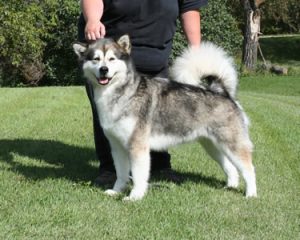
The Alaskan Malamute is a generally large breed of domestic dog (Canis lupus familiaris) originally bred for use as an Alaskan sled dog. It is sometimes mistaken for a Siberian Husky, but in fact is quite different in many ways.
Appearance
The American Kennel Club (AKC) breed standard calls for a natural range of size, with a desired freighting size of 23 inches (584 mm) and 75 pounds (34 kg) for females, 25 inches (635 mm) and 85 pounds (39 kg) for males. Heavier individuals (90 lb (41 kg)) and dogs smaller than 75 pounds (34 kg) are commonly seen. There is often a marked size difference between males and females. Weights upwards of 120 pounds (54 kg) are occasionally seen, but this is uncommon and such dogs are produced primarily by breeders who market a ‘giant Malamute.’ These large sizes are not in accordance with the breed’s history or show standards.
The coat is a dense double northern dog coat, somewhat “harsher” (in a certain sense) than that of the smaller Siberian Husky. The usual colours are various shades of grey and white, sable and white, black and white, red and white, or solid white. Blue and white (slate grey with grey pigment) also is seen in the breed. Eyes are almond-shaped and are always various shades of brown (from dark to light, honey or hazel brown); blue eyed Malamutes will be disqualified in conformation shows, as they would not be a purebred Malamute, but mixed with perhaps a Siberian Husky. The physical build of the Malamute is compact with heavy bone, in most (but not all) cases. In this context ‘compact’ means that their height to length ratio is slightly longer than tall, unlike dogs like Great Danes which are longer and lankier in their ratios.
The primary criterion for judging the Malamute in a show is its function to pull heavy freight as a sled dog; everything else is secondary. As many an owner has found out, the pulling power of a Malamute is tremendous.
According to the AKC breed standard, the Malamute’s tail is well furred and is carried over the back like a “waving plume”. Corkscrew tails are occasionally seen but are faulted in the AKC breed standard (a corkscrew tail is commonly seen in the Akita). The Malamutes’ well-furred tails aid in keeping them warm when they curl up in the snow. They are often seen wrapping the tail around their nose and face, which presumably helps protect them against harsh weather such as blowing snow. Their ears are generally upright.
Temperament
A few Malamutes are still in use as sled dogs for personal travel, hauling freight, or helping move heavy objects, some are used for the recreational pursuit of sledding also known as mushing, also skijoring, bikejoring, and canicross. However, most Malamutes today are kept as family pets or show dogs or performance dogs in Weight pulling or Dog agility or packing. The Malamute is generally slower in long-distance dogsled racing against smaller and faster breeds and their working usefulness is limited to freighting or travelling over long distances at a far slower rate than that required for racing. They can also help move heavy objects over shorter distances.
The Malamute retains more of its original form and function than many other modern breeds. If a dog owner cannot cope with a dog that will not comply with the owner’s every command, a more compliant breed should be selected. This dog has a long genetic foundation of living in the harshest environment imaginable, and many of its behaviours are evolved to conform with “survival of the fittest.” Independence, resourcefulness and primitive behaviours are common in the breed. While intelligent, they are widely believed to be one of the most difficult dogs to train.
There is reason to believe that Alaskan Malamutes sometimes cope poorly with smaller animals, including other canines; however, this has been difficult to document in detail beyond observational data. It is difficult to pinpoint why many Malamute owners have observed this behaviour with smaller animals, though some might speculate this is due to the Malamute’s uniquely divergent ancestry, at one point cross-breeding with wolves. Due to their naturally evolved beginnings, the Malamute tends to have a heightened prey drive when compared to some other breeds of dog. So while Malamutes are, as a general rule, particularly amiable around people and can be taught to tolerate other pets, it is necessary to be mindful of them around smaller animals.
Generally speaking, time and experience will show if a dog can be left unwatched with other household pets. In this respect, it is also important to understand that just because a Malamute is comfortable with other pets, this does not mean it will be comfortable around all other animals it encounters.
Malamutes are quite fond of people, a trait that makes them particularly sought-after family dogs. Despite this, it is important to watch them with small children because of their size and strength, as it is with any comparably sized dog breed, despite generally sweet personalities. Malamutes are nimble around furniture and smaller items, making them ideal house dogs, provided they get plenty of time outdoors meeting their considerable exercise requirements. If they are year-round outdoor dogs, letting them play in a baby pool filled with cold water in summer keeps them cool. In the winter, they love snow.
The majority of Malamutes are fairly quiet dogs, seldom barking like most other dog breeds. When a malamute does vocalise, more often than not they tend to “talk” by vocalising a “woo woo” sound (the characteristic vocalisations of Chewbacca in the Star Wars films are based upon a Malamute named Indiana once owned by George Lucas). They may howl like wolves or coyotes, and for the same reasons.
—————————————————————————————————————–
CARING FOR YOUR DOG NEWSLETTER – Delivered Directly To Your Inbox – Starting Immediately – SIGN UP FOR FREE TODAY
—————————————————————————————————————–
